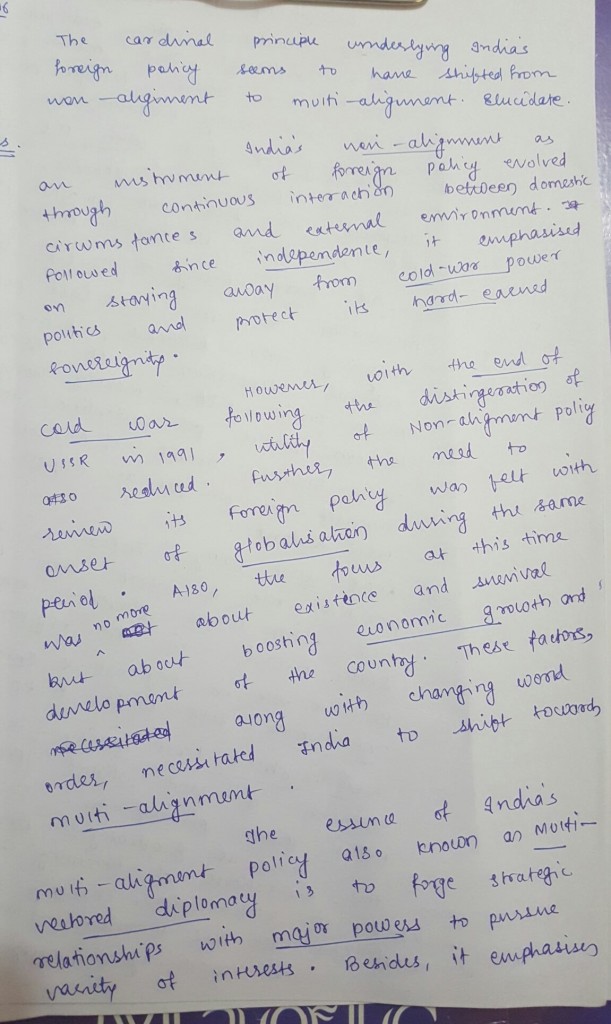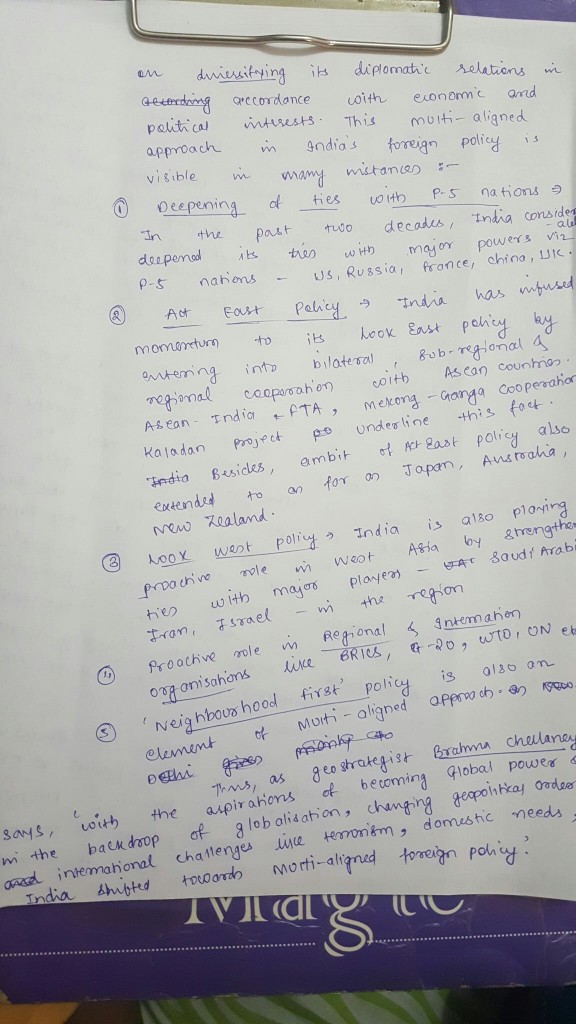IASbaba's Hot Questions, IASbaba's Think Learn Perform 2016, IASbaba's TLP - 2016, Think Learn Perform (TLP)- 2016, UPSC Mains Answer Writing - 2016, UPSC Mains Questions 2016
SYNOPSIS- IASbaba’s TLP 2016 [6th April] – UPSC Mains GS Questions [HOT]
1. What do you understand by the term ‘tax terrorism’? Why this term was in news recently? What are the fallouts of this phenomenon? Explain.
- Intro:
Define tax terrorism: Tax terrorism is when tax authorities adopt regressive and exploitative approach to collect taxes. In this, notices are sent even to people who have duly paid their taxes, extra legal laws are applied to extract taxes, tax benefits are not given, refunds are not made on time and huge penalty is imposed in case of delay in payment of annual taxes.
- Body:
Reasons for being in news:
- Retrospective taxation : Government has resorted to retrospective tax to companies like Vodafone, Cairns India, Nokia etc.
- Minimum Alternative tax (MAT): First government provides different tax exemptions to start business then imposes MAT on it. E.g. : tax imposition in case of FII
- Possible fallouts of this phenomenon:
- increases litigation: this will cause long drawn legal battle which is detrimental to both the industry and economy
- Ease of doing business decreases, India currently ranks 130 decrease in this ranking because of unstable tax regimes will have impact on growth, development, employment creation, etc.
- Both FDI and FII investments will decrease as investors confidence in India will be shaken, as safety of their investments is not guaranteed.
- Companies will not be able to plan ahead, and calculate their rate of return as both the political risk and financial risk will increase.
- The other companies are always in constant fear if they are violating any law, this decreases the pace of their progress,
- .GAAR which gives more powers to taxman will makes matters worse as it will unrestrained power to tax officials.
- Many companies will leave India (Ex Nokia) and even domestic companies look out for tax havens to setup offices e.g. flipkart
- It will also lead to illegal movement of cash like Hawala and money laundering, as honest tax paying companies will anyhow be harassed for more taxes.
- Government’s initiatives like Make in India will be severely hampered as it creates an confusing business environment
- Conclusion:
Briefly write your opinion and conclude the answer.
Best answer: AFFU
TAX TERRORISM:
“Tax terrorism “refers to the adversarial approach of tax administration.
This is a situation where the taxman uses his powers to extract more than what is due from an honest taxpayer
This can be done by unjust and
inequitable tax laws or by enforcing the tax law on the general public
in a harsh manner
RECENT INCIDENTS:
The recent ruling of the court infavour of Vodafone where the government’s claims of violation of transfer pricing agreement by company didn’t stand judicial scrutiny
There has also been other cases where some business entities have preferred to move out of country eg:NOKIA,COLA and many start up which begin in India subsequently have been shifting to abroad
FALL OUTS:
It leads to decline in investor confidence, reflected in poor rankings on ease of doing business
it leads to inability to attract new capital and retain the existing one
economy cannot harness the potential of start ups
tax terrorism leads to individuals, companies shall search for means to evading tax,leading to generation of black money which in turn breeds organized crime and other evils
hence there is need to rationalize tax structure according to recommendations given by expert panels like shome,eshwar committed and direct tax code for direct taxes and bringing in tax reforms indirect taxes like GST to widen the tax net without terrorizing honest tax payers
2. The cardinal principle underlying India’s foreign policy seems to have shifted from non alignment to multi alignment. Elucidate.
Introduction:
Briefly write about the policy of non alignment
One of the distinct features of India post independence was its NAM policy. With the world divided into 2 factions, India took a neutral stand in the Cold War and led a new group of Third World Countries which was based on the policy of independence from great powers and taking its own stand while promoting decolonisation. This helped India formulating its own policy without any external interference and concentrate on its own internal problems .India emerged on the global platform and was benefitted by favours from both the factions without any direct association with them.
Emergence of multi alignment
India had to gradually move from Non Alignment to Multi Alignment soon after breakdown of USSR and opening up of Indian economies by the LPG reforms. The multi alignment especially in present global scenario is the need for India.
Reasons and examples:
1.Energy security – Increasing engagement to African countries , non-traditional middle-east countries like Iran, Afghanistan for diversification of energy resources due to increasing in-stability in middle-east.
2.Economic Security – The rise of TPP, APEC and other trade blocks necessitate to engage with various other countries to protect economic interest. The engagement of India with ASEAN, EU and Canada, India-Africa summit will enhance trade relations.
3.Growing global terrorist activities, hegemony of China in Asia and increasing terrorist activites sponsored by Pakistan required diplomatic global response. The various maritime exercise with South-Asian country, quadrilateral exercise of India, US, Japan, Australia are few steps taken by New Delhi.
4.Social security – The increasing demand of employment opportunity can only be met both through domestic opportunity and opportunity in foreign countries. New Delhi is continuously engaging with US, EU and middle-east to secure the rights of Indian workers.
Benefits:
1) Allows India to absorb the best from different countries while satisfying the needs of energy, investment, defence technology, maritime security.
2)Enhances goodwill and soft power of India to be used in multi lateral forums to voice the concerns of developing nations in terms of climate change and fasten unsc reforms seen through multilateral g4 forum.
3)The change in policy has diversified markets of India and lowered dependency on Russia and US only.
4) Increases the investments in India which will tap the demographic dividend, enhance make in India programme and generate employment.
Challenges:
But there are some challenges in this multi alignment policy such as treading a difficult path when dealing with Iran and Saudi Arabia in West Asia , struggle for supremacy in Asia Pacific between China and USA , Israel and Palestine issue.
Conclusion:
India has improved its relations with almost all its neighbors especially China with whom it is collaborating on many economic projects like BCIM,OROB etc. India has played an imp role in multilateral organisations like IMF,WB,UN etc and has found new organisations like AIIB ,NDB etc. Its leadership in the Paris Summit was appreciated by many. It has strategic partnership with almost all the major power of the world .India’s multi alignment policy has allowed India to secure its interest without any direct confrontation .It should use it to solve its border issues and global issues peacefully and emerge as a global power.
You may also refer to the following articles:
http://www.thehindu.com/todays-paper/tp-opinion/nonalignment-to-multialignment/article8066155.ece
http://www.idsa.in/askanexpert/multi-alignment-non-alignment-india
Best answer: BABA90
http://a.disquscdn.com/uploads/mediaembed/images/3460/624/original.jpg
http://a.disquscdn.com/uploads/mediaembed/images/3460/625/original.jpg
3. In the global supply chain of textiles, where does India stand? Is there any room of upgrading our position towards greater value addition? Examine. Also suggest strategies to meet this end?
Introduction: India’s current stand
India is now a fast emerging market inching to reach half a billion middle income population by 2030. Indian textiles currently rank second in the world after China with respect to textile garments. After agriculture, textiles is the one which provide maximum employment, around 14% Indian population is engaged in this segment and contributes around 4% in GDP.
All these factors are good for the Indian textile industry in a long run. Even though the global economic crisis seems to be worsening day-by-day, as long as economies are emerging and growing as those in South and South East Asia, textile industry is here to grow provided it takes competition and innovation seriously.
Indian textile industry should have focused on all major sectors right from fibre to fashion and planned for an organized growth across the supply chain so as to compete with China and even countries such as Pakistan, Vietnam and Thailand. Instead, the industry had put majority of its stock in the spinning sector. This is clearly evident in the utilization of Technology Upgradation Fund Scheme effectively by the spinning sector. Although it is a positive outcome, it is accepted by many that, the industry turned a blind eye on value-adding sectors such as weaving and finishing.
There is sufficient room to upgrade our position towards greater value addition if the following areas are addressed:
- Indian powerloom sector, which enables value-addition is a highly unorganized industry and needs major upgradation.
- Not only India does not have world quality indigenous shuttleless looms, but also investments are not adequate to cope with the quality and quantity to cater to the export market.
- Technical textiles sector is still in its infancy and a tangible growth will be highly visible by 2035 when the growth in this sector will be exponential.
- Complying with the international best practices and fully gearing to cater to the growing needs of global buyers
- Aligning product and information flow supply chain systems with their suppliers
- Though the chain spans across fibre supply, yarn manufacturing, fabric weaving, processing, apparel making, aggregators, retailers, the clout is in the hands of the front-end. The maximum value add in the supply chain happens at the retail stage (almost 50 per cent) and marketers and merchandisers, therefore, play a pivotal role.
Strategies:
A couple of points given below will give food for thought for all the stake holders in the Indian textile industry:
- The weak links in the Indian conventional industry such as weaving and finishing have to be strengthened. A major thrust here is to have consolidated efforts by Indian Textile Machinery Manufacturers Association, end-users and the Government to undertake a moonshot and come-up with alternatives to European Machinery, which the weaving sector can afford. This should be doable within the next five years, if dedicated efforts are undertaken with the financial support for R & D by the Government through its various schemes; (cite some examples)
- Inch forward in the non-commodity textile sector, i.e., technical textiles sector from a non crawling phase to at least a crawling industry in the next three years.
- General awareness on nonwoven and technical sectors has been created with the recent marathon training workshops and conferences such as, “Advances in Textiles, Nonwoven and Technical Textiles”, organized for the past five years in Coimbatore by Texas Tech University, USA and those such as the Texcellance and IIT’s Technical Textiles conferences. These have put India on the international map in technical textiles.
These steps are conducive for investment and would attract private players both domestic as well as foreign. Increased investment would enhance efficiency and would add value to the Indian textile production.
Best answer: SVSR
Being a tropical country with favourable climatic conditions, India has the top place in producing top quality cotton production. With the export of our fine raw cotton, Manchester has become the textile hub of the world, but India is still struggling to become a textile industry giant. With growing stiff competition from other countries like China, Indonesia, Bangladesh etc., India’s textile industry had seen declining growth rates in the recent past.
India’s exports are limited to cotton and yarn instead of finished goods and that is the reason why we have not reached our forex earning potential and cumulative profits are low. There is lot of room for India’s position towards greater value addition, and is described below:
> Technological upgradation in looms increases fineness and quality of our material.
> Product diversification – identifying and adopting modern necessities like developing technical textiles, performance textiles.
> Goods diversification – building human resources in textiles industry with textile education, clothing, designs (eg. NIFT).
> Adoption of modern practices like chemical dyeing, dyeing with organic materials etc.
> Modern marketing strategies – can make our traditional wear competitive by branding. (eg. Modi suit).
> Promotion of linen and khadi industries to adopt modern designs would increase their value.
Strategies:
> Worthy implementation of Amended Technology Upgradation Fund Scheme for textile industry to encourage local manufacturers to upgrade their technologies.
> Employment generation and export by encouraging apparel and garment industry.
> Promotion of incubation centres for garment industry in Start Up India.
> Promotion of handloom and handicraft goods with GI tags and branding.
> Establishing storage and manufacturing clusters as fineness of cotton is highly sensitive to climatic conditions.
Cotton yields are consistently growing with the implementation of biotechnology like GM Cotton. But the main problem lies in the textile industry itself. Therefore, there is an urgent need to ramp our textile industry with innovative measures to take back India in the top list.
















